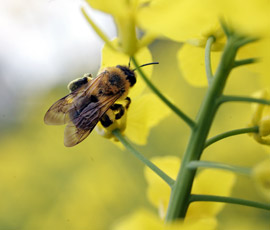US report cites many factors for bee decline

A US agriculture report has concluded a “combination of factors” is responsible for the decline of bees.
Following the EU’s decision to ban neonicotinoids, the study does not single out pesticides as the main culprit behind bee colony crop disorder.
The report, by the US Department of Agriculture (USDA) and the US Environmental Protection Agency (EPA), blames “multiple factors”, including parasites and disease, genetics, poor nutrition and pesticide exposure.
“The decline in honey bee health is a complex problem caused by a combination of stressors,” said EPA acting administrator Bob Perciasepe.
The European Commission will introduce a two-year ban on the use of certain neonicotinoids – which have been linked to bee decline – for use on crops attractive to bees, including oilseed rape and maize, from 1 December.
The ban is being introduced on three products – imidacloprid, clothianidin and thiamethoxam – despite opposition from the UK government and a hung vote among member states in the European Parliament this week.
The report said the parasitic mite, the Varroa mite, remains the “single most detrimental pest of honey bees”.
Pesticides, however, were put at the bottom of the list of factors and the report stated there was no clear evidence they were responsible for bee decline.
“It is not clear, based on current research, whether pesticide exposure is a major factor associated with US honeybee health declines in general, or specifically affects production of honey or delivery of pollen services,” said the National Honey Bee Stakeholder Conference report.
“It is clear, however, that in some instances honey bee colonies can be severely harmed by exposure to high doses of insecticides when these compounds are used on crops, or via drift on to flowers in areas adjacent to crops that are attractive to bees.”
The report recommends that additional research is needed to determine risks presented by pesticides.
“The most pressing pesticide research questions relate to determining actual pesticide exposures and effects of pesticides to bees in the field and the potential for impacts on bee health and productivity of whole honeybee colonies,” said the report.
Luke Gibbs, spokesman for Syngenta UK, which manufactures Cruiser OSR (thiamethoxam), said the report echoed what Syngenta has been saying all along about bee decline.
“The commission’s proposal (to ban neonicotinoids) is based on poor science and ignores a wealth of evidence from the field that these pesticides do not damage the health of bees,” he added.
“Instead of banning these products, the commission should now take the opportunity to address the real reasons for bee health decline: disease, viruses and loss of habitat and nutrition.”
But Jennifer Sass, a senior scientist at the US Natural Resources Defense Council, spoke out in favour of a ban on neonicotinoids – like the one in the EU – while their effects on bees were unknown.
“The bees are in a crisis situation and therefore so is agriculture, and so you take the action that can be taken now,” she said.
“If you already know that neonics are part of the problem then you need to get rid of them.”

